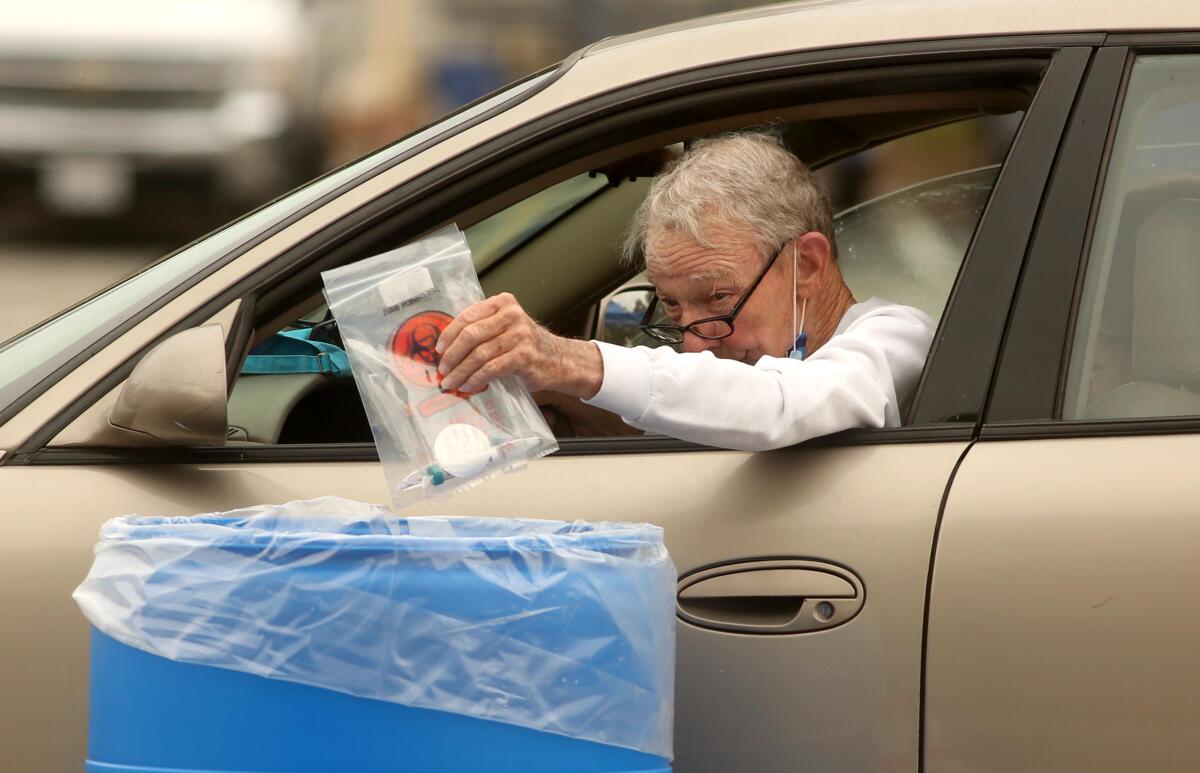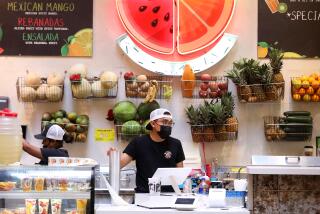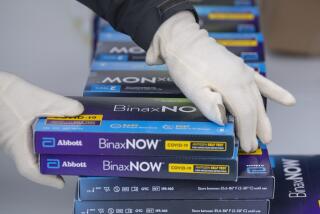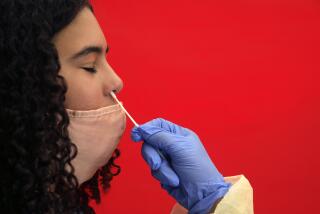California is still way behind in coronavirus testing despite recent advances

State health officials have ramped up coronavirus testing in recent days, but California still lags behind most other states, leaving potentially thousands of undiagnosed patients to unknowingly spread the infections.
As of Tuesday, California said it had results for 143,172 tests — or 362 per 100,000 people. That’s a sharp increase from two weeks ago when just 39 of every 100,000 residents had been tested.
Yet for all its deep sources of innovation, the state is behind the national average of 596 tests per 100,000, according to the COVID Tracking Project. In New York, which has far more people hospitalized with severe symptoms, testing has reached 1,748 of every 100,000.
Some California patients continue to wait many days for results. And for those without symptoms such as a fever, it continues to be extremely difficult to get a test.
The slow testing has been the source of frustration and alarm from public health officials, who say it has limited their understanding of infection patterns and made it harder to slow the coronavirus.
“It’s really important for us to know if they’re positive,” said Barbara Ferrer, L.A. County’s public health director last week, expressing concern that some patients were still waiting 12 days for results. “Both for their medical treatment but also so that we can immediately move those people into isolation, identify their close contacts and have their close contacts quarantined.”
The latest updates from our reporters in California and around the world
While California has not seen the death toll of hot spots such as New York, Ferrer and other county health officials said improving testing is an essential tool the state should be better utilizing. California has recorded 450 deaths and more than 17,000 confirmed cases.
Gov. Gavin Newsom on Tuesday offered a “sense of optimism” to Californians about bending the coronavirus curve. “It is bending, but it’s also stretching,” Newsom said.
Bending the curve means reducing the transmission of the virus to prevent a sudden and large increase of patients with COVID-19. Instead of a rapid surge, infections grow more gradually, essentially “stretching” out a bell curve over time, as Newsom said, to avoid overwhelming the healthcare system with more seriously sick patients than resources to treat them. The state has said it expects a peak sometime in May.
On Saturday, Newsom said the state had turned a corner on testing. He said he was taking responsibility for the state’s poor performance and had created a task force that would work to boost testing five-fold by month’s end.
“It’s a new day,” he declared. “I want to make sure this new promise can materialize.”
Some hospital and university labs have improved from what they describe as “crisis mode” to processing hundreds if not thousands of tests a day. A massive backlog of samples waiting at commercial labs and other facilities has fallen to a fraction of its 60,000-test peak. And Los Angeles Mayor Eric Garcetti said Monday that he would expand testing of people showing symptoms of the virus to sites across the city.
Still, Newsom’s pledge will be closely scrutinized by hospitals, doctors and patients as the lack of available tests has thus far seriously hampered efforts to corral the lethal virus.
Last month, federal and state officials abandoned their attempts to test and isolate anyone infected with the virus, and began implementing communitywide efforts requiring large swaths of the public to stay at home. To lift the stay-at-home restrictions and allow people to return to a more normal life, testing will need to be widespread and easily accessible, public health experts say.
John Ioannidis, a professor of health research and policy at Stanford’s School of Medicine, said without testing officials don’t know the virus’ fatality rate or how aggressively they should respond. Ioannidis said he believes the rate is less than 1%. “I think it’s much smaller,” he said, “and we need to know how much smaller.”
More testing, he said, would allow officials to “be more strategic” in their decisions “rather than continuing blind.”
Testing kits have been in such short supply at the PIH Health Downey Hospital that only patients whose treatment would be altered by a positive result get them, Dr. Jaime Diaz, an emergency physician, said Saturday.
Even doctors and nurses who think they’ve been exposed but lack symptoms don’t meet the criteria, said Diaz, who serves as the hospital’s chief medical officer. The shortage means that for weeks people with mild and moderate symptoms were sent back into the community, he said.
“If you tell [a patient] to go home and quarantine for 14 days, unless you have objective evidence — a positive test — most people after a few days are going to go, it’s going to be OK” and stop taking precautions, Diaz said.
The reasons for the testing failures in California, and more broadly across the nation, are just starting to become clear.
The country first fell behind when a test designed by scientists at the Centers for Disease Control and Prevention was found in early February to be flawed. Federal officials then prevented universities, hospitals, companies and local public health labs from designing their own alternative tests. Those rules, set by the Food and Drug Administration, stayed in place until frustration boiled over and officials began to reverse them on Feb. 29.
Adding to the problems were large backlogs of tests at two large commercial labs, Quest Diagnostics and LabCorp, which had been overwhelmed with test samples after their executives appeared with President Trump at a March 13 news conference in the Rose Garden. Two days later, Newsom announced that Quest’s lab in San Juan Capistrano had offered to help the state ramp up testing.
But Quest Diagnostics was also sending test samples from across the country to that same California lab, extending wait times for some patients to nearly two weeks.
State and federal officials have repeatedly promised solutions that have fallen short of expectations.
In March, both Trump and Newsom touted efforts by a Google sister company called Verily Life Sciences that had developed a website where people could access tests. Trump said the website would quickly be available to Americans. But so far, the company’s testing has been limited to sites in just five California counties and only 3,700 people had been tested by the end of March.
Among other continuing problems have been nationwide shortages of testing supplies, including swabs needed by doctors to collect specimens and chemicals required to preserve and process those patient samples. The labs have struggled even to find enough skilled technicians to run the tests.
There have been signs in recent days that health officials and labs are making progress on the coronavirus response.
Wendy Bost, a Quest Diagnostics spokeswoman, said Monday that the company is now processing coronavirus tests at an additional 11 labs and had reduced its backlog of 160,000 tests on March 25 by 50%. The current backlog of 80,000, she said, corresponds to about two or three days of testing.
LabCorp has also sped up processing. It is reporting results for as many as 40,000 tests a day at four labs, none of which is in California, the company said.
The task force announced by Newsom includes officials from UC San Diego and UC Davis — universities that developed their own tests after federal officials lifted restrictions that had prevented the use of anything but the CDC’s test. Both schools have recently dramatically boosted testing capacity through the use of automated machines.
At UC San Diego, labs are processing about 700 samples a day, according to the university. Officials aim to increase that to 1,500 by mid-April.
Technicians at UC Davis are processing 400 tests a day, said Dr. Allison Brashear, dean of the medical school. Their goal is to soon process 1,000 tests a day, she said. “We’re working around the clock,” Brashear said.
Both universities are also working with the state to establish five to seven hubs with high-volume testing capabilities throughout the state, according to Newsom. He said the state is also partnering with Abbott Laboratories, a large Chicago company, to provide its test at 75 locations. The company says a test can be used in doctor’s offices or urgent care clinics to provide results in as few as five minutes.
The task force is being led by Dr. Charity Dean, assistant director of the state Public Health Department, and Paul Markovich, president and chief executive of Blue Shield of California. It also includes Dr. Christina Kong of Stanford Medicine, Dr. Jeff Schapiro of Kaiser Permanente and Carmela Coyle, president of the California Hospital Assn.
In an interview, Dean said the new partnerships will allow the state to ensure that anyone who is considered a priority for testing can be quickly given results. Those people include hospitalized patients, residents in skilled nursing home facilities, as well as healthcare workers and emergency responders.
“We are very aware that the wait time is more than we want it to be,” she said.
Times staff writers Taryn Luna and Paige St. John contributed to this report.
More to Read
Sign up for Essential California
The most important California stories and recommendations in your inbox every morning.
You may occasionally receive promotional content from the Los Angeles Times.















